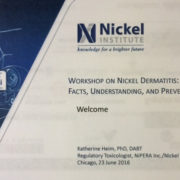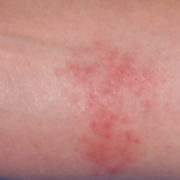Nickel Workshop
On June 23, 2016, a historic event occurred – the first US Nickel Workshop. Thought leaders from medicine, industry and regulation came together to discuss the issue of nickel dermatitis, appropriate uses of nickel, and the integral role of nickel in society at the first North American Workshop on Nickel Dermatitis. This workshop was sponsored and coordinated by the Nickel Institute, who brought toxicologists and dermatologists together with conscientious companies representing various consumer product sectors. The group stressed the importance of nickel release, not nickel content in determining risk of becoming allergic to nickel and having a nickel dermatitis reaction if you are already allergic to nickel.
Removing nickel from our environment is not possible, because it is one of the most abundant metals on our planet and it has many beneficial uses where it cannot be reasonably substituted (e.g. stainless steel) . What is possible, though, is to use it in the safest ways possible. For example, nickel is safely used in several types of stainless steels. Nickel is also used as nickel-plated carbon fibers in the composite case of personal cell phones to keep our brains safe from the electromagnetic energy generated from by cell phone use. A top priority was discussed at the nickel workshop of removing high nickel-release materials from use in piercing posts (used in jewelry) by using appropriate low nickel-releasing materials (e.g. surgical stainless steel, high quality gold, etc.) since piercing directly introduces releasednickel to an open wound. This is especially important for children who, if sensitized, have a lifetime to deal with the consequences.
The Nickel Institute will be putting together a full report from the Nickel Workshop, which will be made available online on the Nickel Institute website at https://www.nickelinstitute.org Dr. Jennifer Chen, MD, a dermatologist from Stanford University, presented the background of nickel allergy in the US at the Nickel Workshop in addition to developing an outreach education webinar on this topic available to the public https://www.dermatitisacademy.com/webinars/ The webinar discusses that EU regulations have decreased nickel allergy in ear pierced young women from 16.6% down to 6.9%. The estimated savings of $2 billion over the last 20 years is massive and that could translate into an even bigger savings with the US population.
At the Nickel Workshop, Dr. Sharon Jacob, MD, a dermatologist from Loma Linda presented the situation of nickel dermatitis in children in North America, noting that nickel allergy is found at an early age and is thought to be largely due to ear piercing in young girls. She reported that an estimated 11% of the US general population is currently sensitized to nickel, which includes an estimated 8,133,603 children! She also stated that a significant proportion of these could be prevented by utilizing safer metals in piercing. Dr. Jacob ended her presentation at the Nickel Workshop with a slide that said:
‘You can’t tell an adult they can’t pierce and smoke… but you can protect a child.’
To learn more about nickel allergy and sensitization, please visit the Dermatitis Academy page dedicated to nickel https://www.dermatitisacademy.com/nickel-page/ which includes information on the low nickel diet, how to DMG test metal objects to screen for nickel release, a quiz on sources of nickel and a general population questionnaire on nickel sensitization. https://emg.wufoo.com/forms/nickel-allergic-contact-dermatitis-survey/



